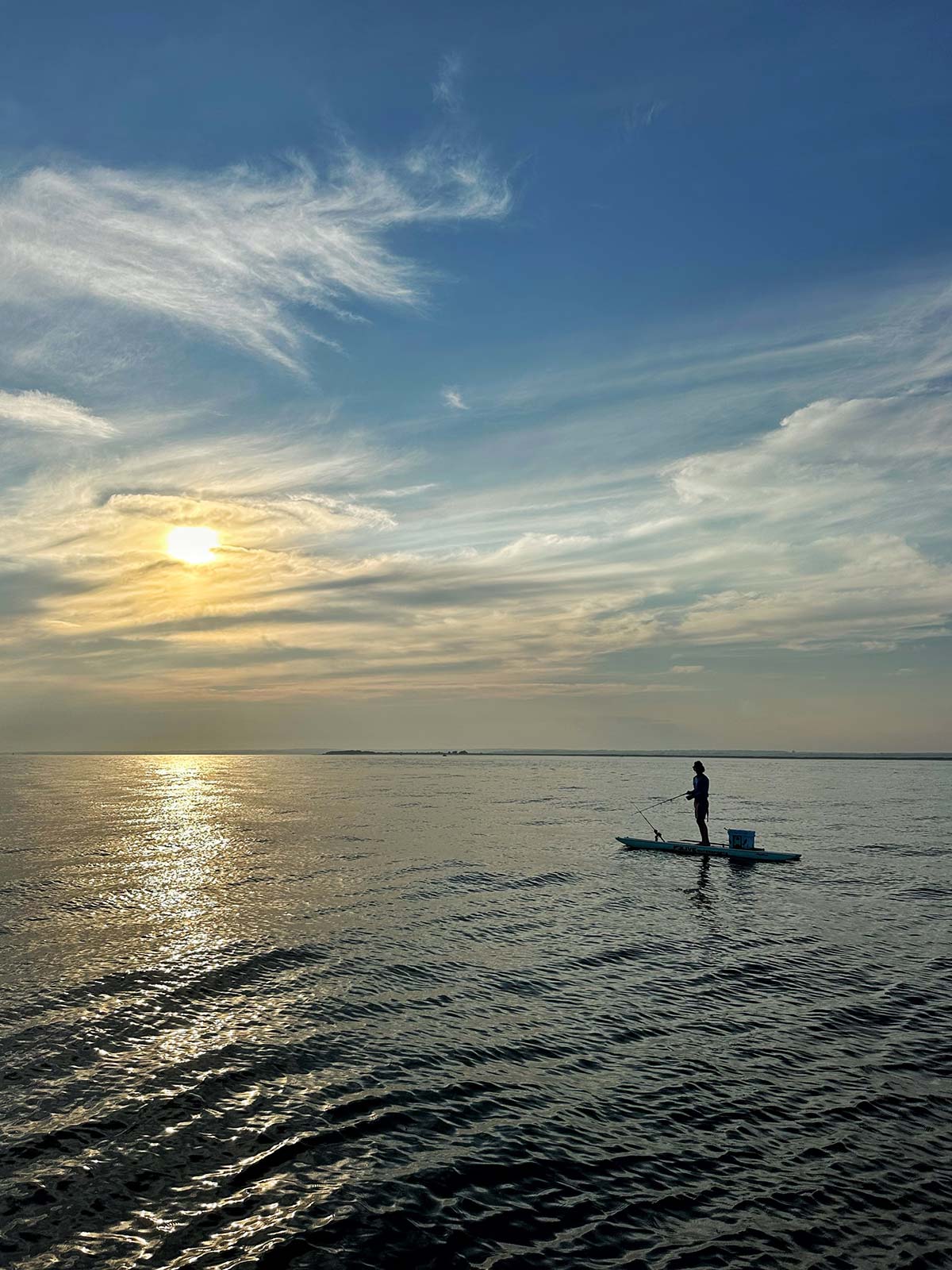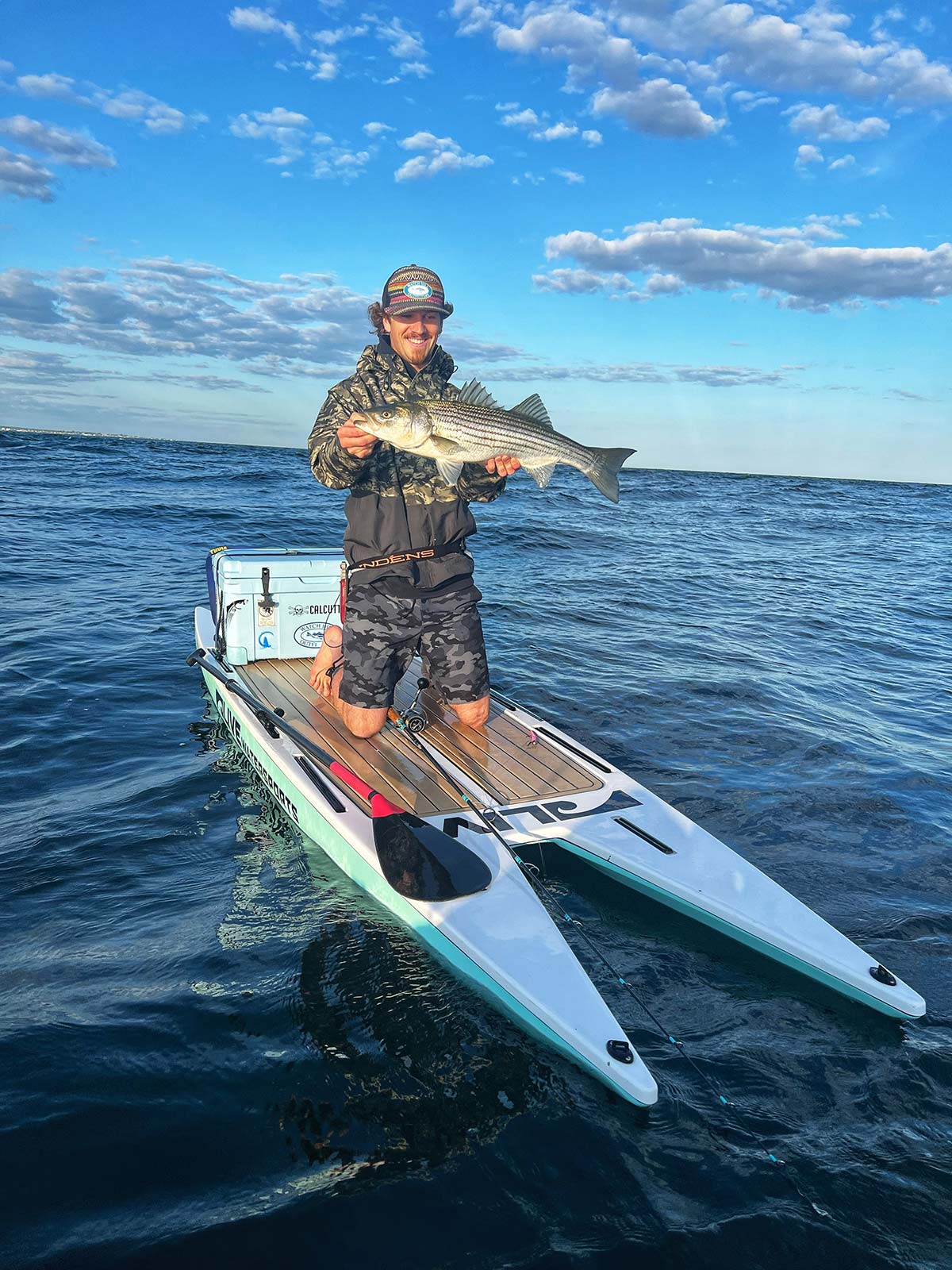
A bare-bones and stealthy approach to fishing the salt.
It’s always fun proving someone wrong, especially when it’s your significant other. My girlfriend and I had been live porgy fishing together before with some limited success, but we had never attempted it from a paddle board. So when 7 p.m. rolled around and I suggested we paddle several-hundred yards from shore into the Watch Hill Reefs, where some of the most infamous rips in New England form with each tide, she was apprehensive to say the least. After bailing about a dozen sea robins to get the rhythm going we made a slight move up-current to a spot I knew we could find some scup. Of course she managed to hook the first one, so I switched her Hogy Squinnow out for an 8/0 Salt-X circle hook, hooked the porgy through the nose and she opened her bail.
After a challenging 10 minutes or so of heckling, I was able to secure a porgy of my own. We made a few drifts inside of the red bell can to no avail, so I handed my rod to Alex and she towed the porgies as I paddled us another hundred yards into the rip. The move put us next to a friend in his Hydra Sport who immediately told us we were insane and then told us that we had good marks under us. The following drift yielded nothing in the first spot, now on our second lengthy drift we were still striking out.
Confidence was waning, especially from my crew; comments like “why are we out here,” “this is boring,” and “I feel bad for the porgy” began to float across the boiling rips. We paddled back up tide to where the smooth water met the rip and reset for another drift. This was the one. Our finned friends started swimming frantically on the bottom, all too aware of what was to come. I came tight, then dropped it. Halfway up the water column he ate again, then he dropped my porgy just under the board, close enough to give me the familiar – and haunting – image of a 40-plus inch fish swimming toward the bottom. Suddenly Alex came tight and the fight was on. The fish swirled around the paddle board as I released my porgy to become an easy meal for the school below. I grabbed the paddle and directed the board toward the fish. Within five minutes, Alex leadered the biggest fish to come to hand on the board since I bought it. She was ecstatic, electric, to have landed such an awesome fish that would have made anyone’s day, no matter the vessel.

Board & Accessories
I got my Live Watersports L2Fish paddle board from Watch Hill Outfitters in July 2020. Like many others, I wanted to get as far away from people as possible that summer, a perspective brought on by many factors not the least of which was working retail in a tackle shop during a time when everyone and their uncle suddenly became interested in fishing. A 12-foot-6 seafaring paddle board rigged with a cooler and rod holders seemed like a pretty good way to beat the crowd. It’s been a learning curve but these days it’s arguably my favorite way to fish the salt.
My gear varies depending on what the program is but there are certainly a few things I can’t leave shore without. L2Fish paddle boards come with tracks installed all over the board that are compatible with Yak Attack accessories. I set up one to two rod holders, a roto grip paddle holder, and two tie downs to affix my cooler. The cooler I use is a 35-liter Calcutta which I tie down with a simple flat strap over the top. Usually it serves as dry storage for my phone, camera gear, food, and tackle boxes, but if I plan to keep fish I pack it with ice and keep a tray inside for tackle. If I plan to fish live bait, the cooler can also double as a live well with the addition of a bubbler.
I like to fish a 7-foot, 6-inch rod on the board such as the Watch Hill Outfitters custom sticks or the Tsunami Carbon Shield. These rods will be outfitted with sealed reels because the best things in life are wet when it comes to paddle board fishing. Braided line between 15- and 30-pound test is average for me with mono of the same strength for my leaders. Having Tactical Anglers clips on the end of every leader is a must as well. Often times I’m switching lures or techniques four to five times on deck, and having the versatility can mean the difference between making the cast or fumbling with knots while the fish sail past.

Endless Possibilities
Some of my favorite lures to bring on the L2Fish are the Hogy Squinnow, Stevo’s Custom Bucktails, Albie Snax, Gravity Tackle (GT) Eels, and of course some Tsunami Salt-X circle hooks. The Squinnow is a highly versatile jig that I will use both casting and vertical jigging. It is extremely effective at catching porgies, sea bass, and mackerel but I’m often pleasantly surprised by hooking into schoolie bass and even bluefish and fluke.
Bucktails are a classic that one should never leave home without; whether working them on the bottom with a strip of fresh sea robin belly or casting them into the rips to imitate squid, they’re a go-to. Albie Snax are the not-so-secret weapon of many anglers and it turns out they catch a lot more than just false albacore. GT Eels are my most effective soft plastic for large bass; if I know there are larger stripers around, they’re almost always the first thing I reach for. Of course, if you just can’t make it happen with the synthetics, live bait is an excellent option to put a personal best on the deck. Bang for your buck it’s hard to go wrong with Salt-X circle hooks, they’re sharp and strong.
Fly fishing from the paddle board is another avenue. There’s nothing quite like taking a $1,000 Thomas and Thomas Sextant with a $700 Hatch reel on it to catch 9-inch porgies on a $2,000 paddle board, it really puts things into perspective (hopefully my girlfriend skips that part). All kidding aside, it can be an amazing way to fish the flats. The fact that it only draws inches of water means one can access areas that are less pressured and often overlooked.
When on the fly I bring a tall stripping bucket which I keep in front of me to keep the fly line organized and a dumbbell anchor of only 5 or 10 pounds. Make sure you go as light as you can on the anchor because if you hook the bottom and a wave comes, the board will buck you faster than an electric bull. Typically I will fish a two fly setup on a maximum of 15-pound test leader and cycle through the box until something stands out. Sand eels, shrimp, and even crab patterns can be the ticket but it’s important to have a good knowledge of what the local forage is at any given time.

A New Spark
Anyone who has been into a hobby for their whole life will eventually find it monotonous, if only a fleeting feeling, until the spark reemerges. Finding myself somewhat burnt out by the usual game of center consoles on the reefs and wading the surf, the paddle board brought a new edge to fishing. Figuring out how to be efficient on a vessel where gear is highly limited and mobility is at a premium is an evolving challenge. It forces the angler to hone in on the task at hand and create a plan before venturing out. Having the wrong tackle for the job can mean a long paddle back with tail tucked and an empty cooler, so the versatility of the selection that travels with you makes all the difference.
| BALANCE BOARD BASSING |
| I’ve been using paddle boards since they began to gain popularity when I was a kid. My uncle rented me one from Paddlesurf RI when they had their rental stand right out in front of the Ocean House Hotel. Surprisingly, my first attempt to stand on one went pretty well, I was even able to ride a wave back into the beach. That paddle board was more like a surfboard, and although there are some intrepid individuals who fish off of boards like these, I would only recommend using a board that’s designed for fishing and, as far as I’m concerned the L2 Fish is the clear frontrunner in that category. It’s almost more boat than paddle board when it comes to stability, customization, and range due to the ease of paddling. The twin hull catamaran style design makes it unbelievably stable as well as easy to paddle. Combining that with a 500-pound weight capacity and it’s an easy choice for any angler. |
However, fishing on the paddle board feels less formal; the stakes are lower. I’ve never had to burn a whole fuel bill on a fishless trip, unless a Cliff Bar counts. The pressure to catch your limit or even avoid a skunking isn’t quite so extreme when it feels like you’ve already accomplished enough just by maintaining your balance while casting. I’ve never had to Bust-Out-Another-Thousand on repairs, storage fees, or slip space…and as far as I know, nobody has made “paddle board” into an acronym yet. My point is, corny as it may sound, that taking an expedition on the Live Watersports L2Fish or any other paddle board is an adventure all its own.
Catching fish is certainly a welcome bonus, but the experience of being on the water doing something unique is good enough. People constantly ask why I don’t get something with an engine (in actuality you can mount an engine right on the back of the board!) My favorite response is simply “I am the engine.”



